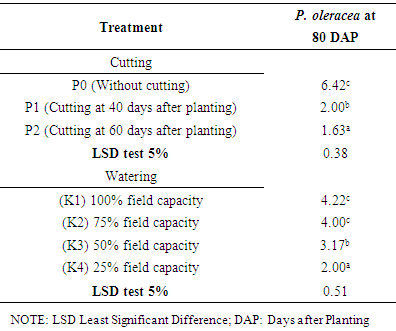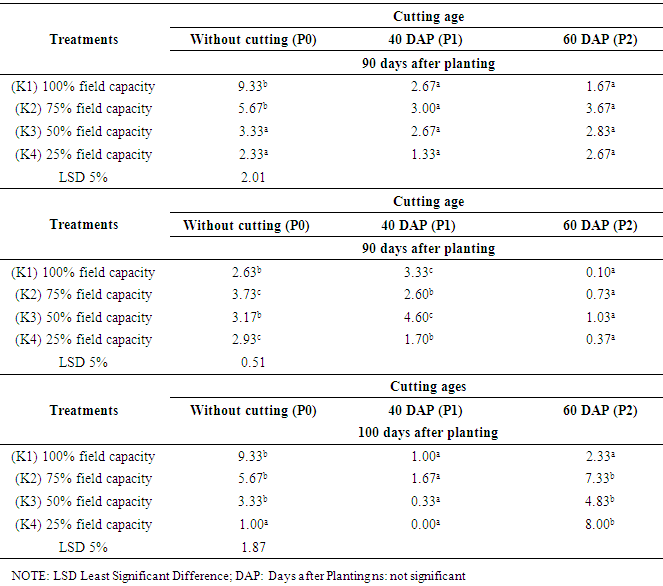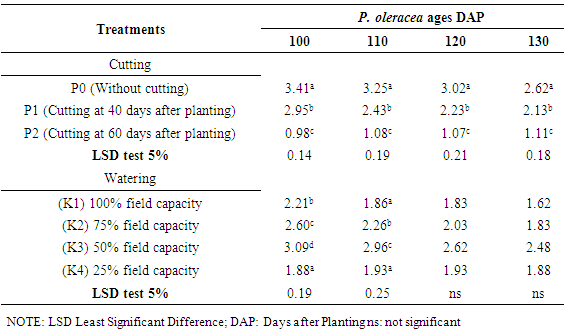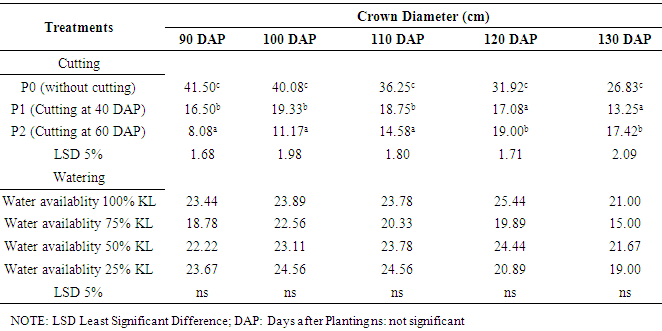-
Paper Information
- Paper Submission
-
Journal Information
- About This Journal
- Editorial Board
- Current Issue
- Archive
- Author Guidelines
- Contact Us
International Journal of Plant Research
p-ISSN: 2163-2596 e-ISSN: 2163-260X
2016; 6(1): 1-6
doi:10.5923/j.plant.20160601.01

Effect of Cutting and Watering of Portulaca oleracea L. on Weeds Control
Zauzah Abdullatif 1, Husni Thamrin Sebayang 2, Sudiarso 2, Agung Nugroho 2
1Faculty of Agriculture, Khairun University, Ternate, Indonesia
2Faculty of Agriculture, Brawijaya University, Malang, Indonesia
Correspondence to: Zauzah Abdullatif , Faculty of Agriculture, Khairun University, Ternate, Indonesia.
| Email: |  |
Copyright © 2016 Scientific & Academic Publishing. All Rights Reserved.
This work is licensed under the Creative Commons Attribution International License (CC BY).
http://creativecommons.org/licenses/by/4.0/

Portulaca oleracea L. (Krokot) is a weed which have capability to decrease 50% crop production and have a high adaptation on dry and wet land. This research aims to evaluate effect of cutting and watering to suppress P. oleracea growth. Randomized design factorial followed by Least Significant Difference (LSD) test were used as research design. Cutting treatment consist of control (P0), cutting primary branch in 40 days after planting (DAP) (P1) and cutting primary branch in 60 DAP (P2). Whereas, watering treatment was design as 100% field capacity (K1), 75% field capacity (K2), 50% field capacity (K3) and 25% field capacity (K4). Results showed that the highest number of P. oleracea capsules (2.718) and seeds (135.917) were founded on treatment without cutting and 50% of watering. While the lowest number capsules (351) and seeds (17.533) were found on cutting treatment in 40 DAP and 100% of watering. It can be concluded that combination between cutting and watering significantly affect on branch number, stem diameter, leaf surface area, capsules and seeds number.
Keywords: Krokot, Weeds, Water availability, Cutting
Cite this paper: Zauzah Abdullatif , Husni Thamrin Sebayang , Sudiarso , Agung Nugroho , Effect of Cutting and Watering of Portulaca oleracea L. on Weeds Control, International Journal of Plant Research, Vol. 6 No. 1, 2016, pp. 1-6. doi: 10.5923/j.plant.20160601.01.
Article Outline
1. Introduction
- Krokot (Portulaca spp.) is a xerophyte plant which classified as weeds and well-grown in wet and dry area [1]. This weed often associated with various vegetables such as nut, sweet potato, soybean, corn, tomato, garlic and onion [2]. It cause 50-80% decline in production [3]. This plant can growth so fast vegetatively and generatively [4]. Moreover, Portulaca spp. can produce 240.000 seeds in a cycle and able to generate roots on cropped stem [5]. Portulaca spp. also have unique photosynthetic process which able to induces crassulacean acid metabolism (CAM) in drought stress [6, 7] and able to do C4 photosynthetic when water is abundant [8].There are some effective efforts to control Portulaca spp. growth; pullout and weeding (before 30 days old). However, stem cutting of P. oleracea at 40 and 60 days after planting were done to discover the influence of stem cutting time to capsules maturity. Then, the environment characteristics that support or inhibit growth were analyzed to contribute in weeds control strategy.
2. Materials and Methods
2.1. Research Location
- This research was conducted at the green house of Agriculture Faculty, Muhammadiah University and Analysis procedures were done at Environmental Resources Utilization Laboratorium of Agriculture Faculty, Brawijaya University, Malang, East Java, Indonesia.
2.2. Materials
- P. oleracea seedlings were used plants which already grew 4-6 leaves. Planting medium was consisted of a mixture of soil: sand: manure fertilizer (1:1:1) in 15x30 cm polybag.
2.3. Methodology
- Randomized design factorial followed by LSD 0.05 and treatment was consist of cutting and watering. Cutting treatment consist of control-without cutting (P0), once cutting primary branch at 40 days after planting (P1) and once cutting primary branch at 60 days after planting (P2). Whereas, watering treatment consist of 100% field capacity (K1), 75% field capacity (K2), 50% field capacity (K3) and 25% field capacity (K4). Both of treatments resulting combination of 12 treatments with 3 repetitions and were observed once in 10 days. Variables which observed in the this group were secondary branches, stem diameter (mm), plants diameter (cm) and root length (cm). Besides, leaf surface area (cm), capsules and seeds number per plant were observed for one life cycle (130 days after planting).
2.4. Data Analysis
- The data were analyzed using t-test at 0.05 level of probability and LSD applied as post hoc test to find significant value (P<0.05).
3. Result
3.1. Branches Number
- There is a significant difference in branch number of cutting treatment and without cutting treatment (P0) (Figure 1). Krokot (P. oleracea) with cutting treatment showed decrease brach numer at 90 and 100 Dap. It means that there is relationship between cutting and watering variables.
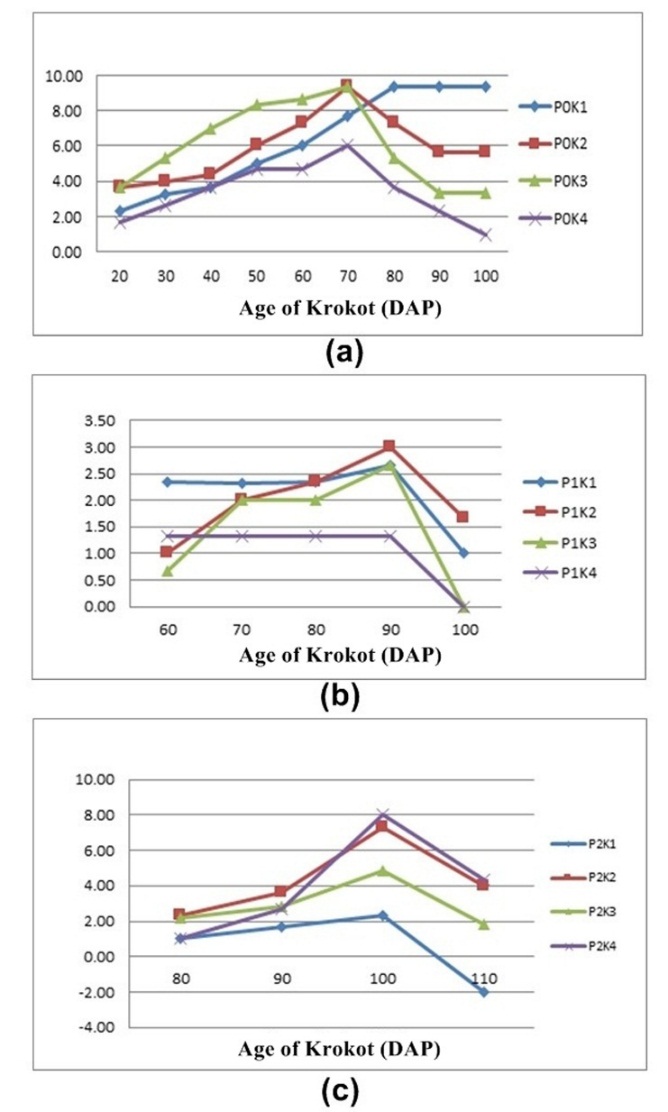 | Figure 1. Branches number: (a) without cutting (P0); (b) 40 days after planting; (c) 60 days after planting |
|
|
3.2. Stem Diameter
- The biggest stem diameter was found on without cutting and 25% watering treatment at 90 days after planting (P0K4) and cutting treatment on 40 and 60 days after planting with 50% water treatment at 90 days after planting (4.60-P1K3) and 110 days after planting (1.86-P2K3) (Figure 2). It shows that cutting at 60 days after planting still allows the growth of stem diameter before entering the stage of death (Table 2).
 | Figure 2. P. oleracea stem diameter size: (a) without cutting (P0); (b) Cutting at 40 days after planting; (c) Cutting at 60 days after planting |
|
3.3. Crown Diameter
- Based on Figure 3a, P. oleracea crown diameter growth reached the greatest on the without cutting treatment at 90 days after planting with 25% watering treatment (43,67 cm). If water availability us low, So the crown diameter increased (aged 100 days after planting with 75% and 25% watering treatment) (Figure 3b). Yet, on 25% watering treatment (P2K4), the increase of crown the diameter are still ongoing.
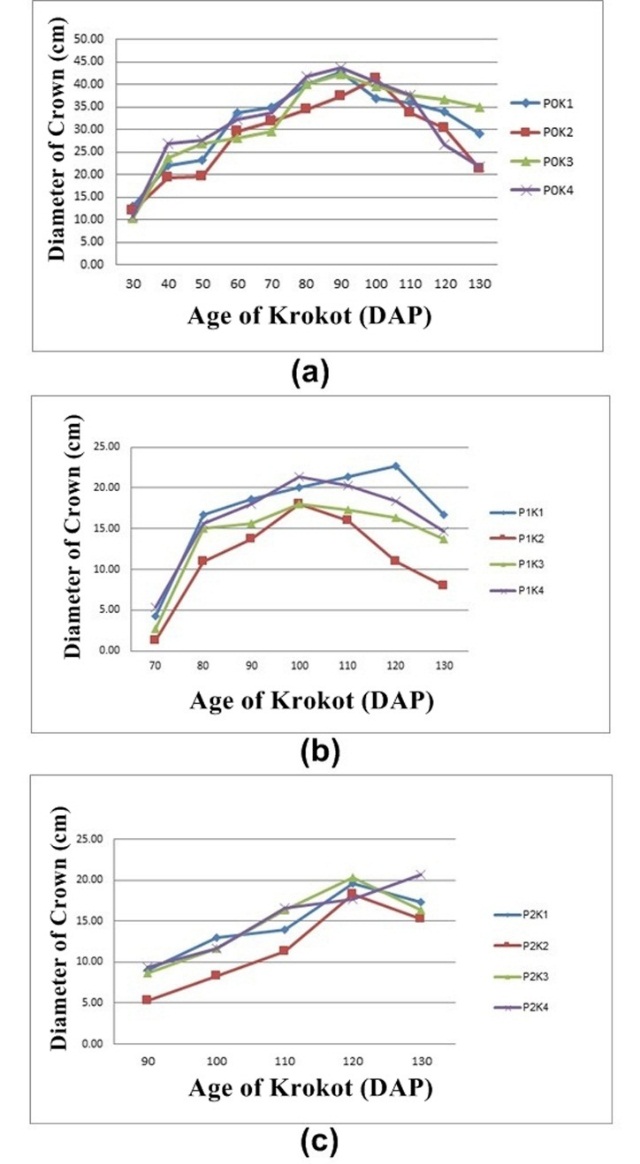 | Figure 3. P. oleracea’s crown diameter: (a) Without cutting (P0); (b) 40 days after planting; (c) 60 days after planting |
|
3.4. Leaf Surface Area
- The cutting treatment influenced on leaf surface. P. oleracea without cutting and 50% watering treatment (P0K3) has the largest leaf surface (267.96 cm2). The smallest area (44,63 cm2) was founded on cutting treatment at 40 days after planting with 100% watering treatment (P1K1) also on cutting at 60 days after planting with 75% watering treatment (46.39 cm2 - P2K2) (Table 5). P0K3 treatment tends to affect in metabolic processes such as the addition of leaf surface.
|
3.5. Capsules Number
- The combination between cutting and watering treatment affect to total capsules number (Table 5). The highest number of capsules were founded at plants without cutting and 50% watering treatment.P. oleracea can live in all water availability conditions and proved by high number of capsules production at 25% - 50% watering treatment. Otherwise, the small quantities of capsule on cutting treatment at 40 days after planting with 100% watering treatment indicated that water availability will suppress the growth.
3.6. Seeds Production
- The average number of seeds ranged between 60-80 per capsule. P. oleracea at 40 days after planting with 100% watering treatment (P1K1) produce the smallest amount of seeds (17,533), while without cutting and 50% watering treatment (P0K3) generate the highest number of seeds (135,917).
3.7. Root Length
- Cutting and watering treatment not significantly affect to root length. In Figure 4, P. oleracea without cutting and 50% watering treatment (P0K3) have the longest root (27.33 cm).
 | Figure 4. P. oleracea root length at 130 days after planting |
4. Discussion
- Branch number was influenced by cutting or without cutting treatment. Appropriate to Notani, et al., cutting process also plays an important role for new shoots formation [9]. The increase of branches number will also affect to the number of capsules and seeds [5]. The cutting at 40 days after planting can be used to suppress branches and capsules production.Beside that, treatment also influenced the stem diameter because cytokinins on lateral buds are causing differentiation of lateral buds transport tissue [10]. It allows nutrients transport for lateral buds for growing. This related to results of lateral branch number and diameter. P. oleracea without cutting treatment have great stem diameter. That because the metabolic activity in plants without cutting treatment was continued. While the plants were cut would stimulate the new shoots [11].The increasing of leaf surface, leaf thickness reduction and increasing in chlorophyll content enables to capture of light more efficiently. Furthermore, the photosynthesis process is usually proportional to leaf surface for capsule and seeds formation [12]. Yasemin explained that drought stress can decrease the photosynthesis rate occurs due to stomatal closure [13]. However, it did not happened in P. oleracea because its ability to photosynthesized on CAM metabolism. According to Galinato et al., P. oleracea produce 9,4 seeds per capsule depend on environmental conditions [14-17]. Udin et al., stated that P. oleracea is productive weed that resistant to poor environment [18]. These results appropriate to Herdiawan, et al., which state that there is no correlation between drought stress and pruning intervals against root length [19]. P. oleracea is an adaptive plant. Long root is strategy to maximize the nutrients and water for capsule production [20].
5. Conclusions
- P. oleracea growth can be suppressed by cutting and watering treatment. They combination of treatment can reduce the number of branches, leaf surface, number of capsules and seeds. Cutting also can reduce the crown. However, cutting without wateing treatement would affect plants diameter and capsules produced. Moreover, cutting treatment also increase the growth 20 days longer. Cutting at 40 days after planting in 100% water availability can be a strategy for weed control beause it can suppress plants growth.
ACKNOWLEDGEMENTS
- The author thank to Directorate General of Higher Education (DGHE), Ministry of Research (DIKTI) for support this research.
 Abstract
Abstract Reference
Reference Full-Text PDF
Full-Text PDF Full-text HTML
Full-text HTML